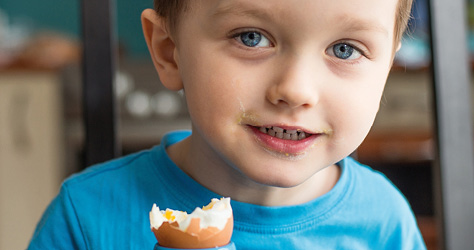You are not alone. Here’s some advice for dealing with picky eaters.
Almost all two-year-olds go through a phase of fussy eating: maybe they’ll want pasta and cheese every night, maybe they can’t bear different foods touching each other on the plate - and as for tasting anything new....forget it, Mum.
The good news is that it’s a very common phase and it will pass, usually by aged four. This complete suspicion of new food even has an official name – neophobia.
At a glance
- Almost all two-year-olds go through a phase of fussy eating
- It’s a very common phase and it will pass, usually by aged four
- It’s perfectly normal to have to offer a new food 15 to 20 times before a fussy eater will try it

Is it science?
Scientists think it’s an ancient evolutionary strategy for toddlers to avoid potentially harmful ingredients once they’re mobile and can ‘forage’ for food. It’s no accident that the foods they reject most often are vegetables and meat – the ones which could do them most harm if rotten.
Power
Your two-year-old will be asserting their independence in all sorts of areas now –and food is a key one. All of a sudden they’ve discovered they can refuse to eat broccoli, beef or peas, and they enjoy their first real taste of power.
It might be a liberating moment for them but it can come as a shock to us. And because we’re desperate for our little ones to eat the nutritious food we’ve lovingly prepared, we get anxious. We hover over them expectantly, zooming their broccoli-loaded spoon like an aeroplane towards their mouth, or pleading ‘just one more pea for mummy’. They soon realise they’re in control, and refuse all the more. And so the cycle continues.
If that’s you – don’t worry. Every mum has been there. We all do the wrong things, just because we’re so anxious they eat a good diet, and we’re cross we’ve just wasted our time making a nice meal they won’t touch.
Step Back
The answer is to step back. Hovering over them counting bites is creating pressure for them and allowing them to take control. Instead, sit down at the table with them, even if you’re not eating a meal. Chat to them and give lots of positive attention (don’t be on your phone or reading a magazine). But don’t talk about the meal or food. The idea is that everyone is relaxed. There’s not much point sitting there for 20 or 30 minutes either, so keep mealtimes short – realistically, if the food isn’t eaten in the first 10 minutes it probably won’t be.
Sit down and eat with them
If you can eat with them, do. This really works as they see you eating the same food and will be more likely to try it. It also takes the focus away from them and stops you hovering.
Stay Calm
If they don’t eat the food you’ve put in front of them, just take it away without commenting or sighing and slamming the bowl down (even though you really, really want to). Take all the emotion out of your response: pretend you really don’t mind if they eat or not. Let them get down, but don’t offer them snacks five minutes later as the lesson will be lost.
Let them work up an appetite
If they’re hungry for the next meal and haven’t loaded up with snacks, milk or juice, they’re more likely to eat the food in front of them. Taking them to the park for a run before a meal also helps boost their appetite.
Offer new foods regularly
It’s really important to keep offering new foods, too, but quietly and without ceremony so they don’t pick up that you really, really want them to like cabbage, beans or avocado. It’s perfectly normal to have to offer a new food 15 to 20 times before a fussy eater will try it. Keep the portion bite-sized, and remove it without comment or perhaps just a brisk ‘oh well, maybe next time’ if they don’t eat it. Don’t assume because they’ve rejected it once they’re never going to like it.
Tastes Change
Tastes change. Some of the fussiest toddlers around turn into gourmet five-year-olds. If you keep consistent, keep calm and keep cheerful (even if it is through gritted teeth) your little one will get there in the end. We’ve got more great tips for encouraging your little one to eat.